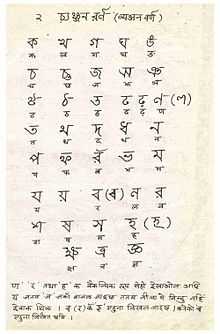Tirhuta
| Tirhuta, Mithilakshar | |
|---|---|
| Type | |
| Languages | Maithili |
Time period | c. 15th–mid 20th century |
| ISO 15924 |
Tirh, 326 |
| Direction | Left-to-right |
Unicode alias | Tirhuta |
Unicode range | U+11480–U+114DF |
Tirhuta (तिरहुता / তিরহুতা) or Mithilakshar (मिथिलाक्षर / মিথিলাক্ষর) is the script used for the Maithili language originated in Present-day Janakpur in Mithila region of Nepal and the oldest reference to Tirhuta Script is in Janaki Mandir of Janakpur where Rama and Sita wed.[1] The script has a rich history spanning a thousand years, but years of neglect by Nepal and the Bihar government have taken their toll on the use of Tirhuta. Most speakers of Maithili have switched to using the Devanagari script, which is also used to write neighboring Central Indic languages such as Nepali and Hindi. As a result, the number of people with a working knowledge of Tirhuta has dropped considerably in recent years.
Description
The related script used in West Bengal and Bangladesh is commonly called Bengali alphabet. In fact, many letters of Bengali alphabet (e.g. ক /k/, খ /kʰ/, দ /d̪/, জ /dʒ/) are written the same in both Tirhuta and Bengali. Nevertheless, there are sufficient differences between the two scripts to somewhat impede mutual comprehension. For example, the letter representing the sound /r/ in Tirhuta has the same form as the Bengali letter ব /b/, and the Bengali letter র /r/ has the same shape as the Tirhuta letter /w/. Furthermore, many of the conjunct letters and vowel signs mean different things in the two scripts. For example, the conjunct ত্ত represents a geminate voiceless unaspirated dental stop /t̪/ in Bengali script, but it represents the syllable /t̪u/ in Mithilakshar.
History and current status
The oldest specimen of Tirhuta is a Janaki Mandir at Nepal. It is one of the place that had a major role in the development of the Sanskrit language. Despite the near universal switch from Tirhuta to the Devanagari script for writing Maithili, some traditional pundits still use the script for sending one another ceremonial letters (pātā) related to some important function such as marriage. Fonts for this script were developed in 2003. [2]
The 2003 inclusion of Maithili in the VIIIth Schedule of the Indian Constitution having accorded official recognition to it as a language independent of Hindi, there is a possibility that this might lead to efforts to reimplement Tirhuta on a wider basis, in accord with similar trends in India reinforcing separate identities.
Image gallery
The first two images shown below are samples illustrating the history of Tirhuta. The first is the sacred sign of Ganesha, called āñjī, used for millennia by students before beginning Tirhuta studies. Displayed further below are images of tables comparing the Tirhuta and Devanagari scripts.
Unicode
Tirhuta script was added to the Unicode Standard in June 2014 with the release of version 7.0.
The Unicode block for Tirhuta is U+11480–U+114DF:
| Tirhuta[1][2] Official Unicode Consortium code chart (PDF) | ||||||||||||||||
| 0 | 1 | 2 | 3 | 4 | 5 | 6 | 7 | 8 | 9 | A | B | C | D | E | F | |
| U+1148x | 𑒀 | 𑒁 | 𑒂 | 𑒃 | 𑒄 | 𑒅 | 𑒆 | 𑒇 | 𑒈 | 𑒉 | 𑒊 | 𑒋 | 𑒌 | 𑒍 | 𑒎 | 𑒏 |
| U+1149x | 𑒐 | 𑒑 | 𑒒 | 𑒓 | 𑒔 | 𑒕 | 𑒖 | 𑒗 | 𑒘 | 𑒙 | 𑒚 | 𑒛 | 𑒜 | 𑒝 | 𑒞 | 𑒟 |
| U+114Ax | 𑒠 | 𑒡 | 𑒢 | 𑒣 | 𑒤 | 𑒥 | 𑒦 | 𑒧 | 𑒨 | 𑒩 | 𑒪 | 𑒫 | 𑒬 | 𑒭 | 𑒮 | 𑒯 |
| U+114Bx | 𑒰 | 𑒱 | 𑒲 | 𑒳 | 𑒴 | 𑒵 | 𑒶 | 𑒷 | 𑒸 | 𑒹 | 𑒺 | 𑒻 | 𑒼 | 𑒽 | 𑒾 | 𑒿 |
| U+114Cx | 𑓀 | 𑓁 | 𑓂 | 𑓃 | 𑓄 | 𑓅 | 𑓆 | 𑓇 | ||||||||
| U+114Dx | 𑓐 | 𑓑 | 𑓒 | 𑓓 | 𑓔 | 𑓕 | 𑓖 | 𑓗 | 𑓘 | 𑓙 | ||||||
| Notes | ||||||||||||||||
References
- ↑ Pandey, Anshuman. "oldest reference to Tirhuta Script in Janaki Mandir where Maithili language originated" (PDF). Retrieved 3 July 2014.
- ↑ Pandey, Anshuman. "N4035: Proposal to Encode the Tirhuta Script in ISO/IEC 10646" (PDF). Retrieved 3 July 2014.
External links
- free Download Tirhuta (Maithili) Fonts
- Tirhuta Lipi: Native Script of Maithili
- Mithila Online
- Learn Mithilakshara by Gajendra Thakur
| ||||||||||||||||||||||||||||||||||||||||||||||||||||||||||||||||||||||||||||









